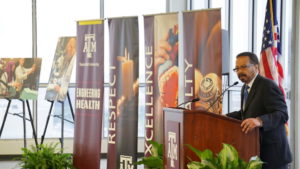Texas A&M Board Authorizes Participation in Innovative Biomedical Research Campus in Houston

TMC3 Could Include UT, Baylor and MD Anderson
 COLLEGE STATION, Texas — The Texas A&M University System officials announced Tuesday that the System’s flagship university has taken a step toward expanding its presence at the Texas Medical Center in Houston and becoming part of a broad collaborative research campus.
COLLEGE STATION, Texas — The Texas A&M University System officials announced Tuesday that the System’s flagship university has taken a step toward expanding its presence at the Texas Medical Center in Houston and becoming part of a broad collaborative research campus.
Besides Texas A&M University and its Health Science Center, the proposed collaborative translational research campus at the medical center, which has been dubbed the “TMC3 Campus,” will include Baylor College of Medicine, the University of Texas MD Anderson Cancer Center and UT Health Science Center at Houston as founding institutions.
The TMC3 Campus is a proposed collaborative effort among governmental and charitable research institutions to establish a premier research campus for biomedical innovation and commercialization. The campus would be a place for scientists to showcase world-class research, and it would serve as a hub for clinical research, genomics, health policy and regenerative medicine institutes.
On Tuesday, The Texas A&M University System Board of Regents authorized Chancellor Sharp to negotiate the necessary agreements with the Texas Medical Center and the other institutions. This action gives the Chancellor authority to work with the various partners on a strategy that will make this visionary campus a reality.
“This campus will transform the medical community in Texas forever,” Chancellor Sharp said. “I believe the innovation and research that will be developed by The Texas A&M University System at the TMC3 Campus is going to save lives, improve health and spark incredible advances in medicine.”
TMC has proposed a 30-acre site for the TMC3 Campus, which will be located in the TMC’s mid-campus. The current project plan includes a large building in the center of the project to be shared by all five participating institutions, to be surrounded by four other buildings – one for each founding academic institution – to offer unique research, lab and ancillary space.
Background information on Texas A&M University and Health Science Center & the Texas Medical Center
Texas A&M University Health Science Center has had a research presence in the TMC since 1999 when it was formed and the Albert B. Alkek Institute of Biosciences and Technology, or IBT.
The IBT originally was formed in 1983 as part of Texas A&M University. It offers graduate and postdoctoral education degree programs and provides a bridge between Texas A&M-affiliated research investigators and scientists across the TMC and the growing biotechnology sector in Houston.
The proposed TMC3 Campus will allow for the growth of the IBT, which already has maxed out its space in the 11-story research Alkek Building.
About The Texas A&M University System
The Texas A&M University System is one of the largest systems of higher education in the nation, with a budget of $4.55 billion. Through a statewide network of 11 universities and seven state agencies, the Texas A&M System educates more than 148,000 students and makes more than 22 million additional educational contacts through service and outreach programs each year. System-wide, research and development expenditures exceeded $972 million in FY 2016 and helped drive the state’s economy.
Contact: Laylan Copelin
Vice Chancellor of Marketing and Communications
(979) 458-6425
(512) 289-2782 cell
lcopelin@tamus.edu